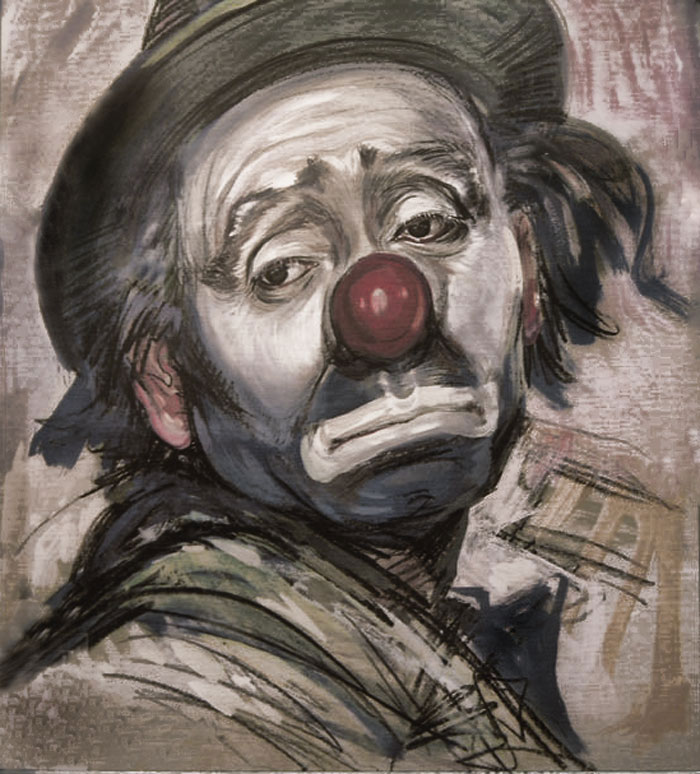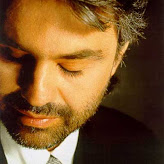The sad clown!

I just could not decide between two artworks I really liked. And since both were the same concept, I chose the one that would help me better with this project.
As you may realize by now, I chose a classic between classics: The sad clown. There have been so many sad clowns in the painting history (practically each one made by an amateur), that this topic is hardly new. Yet, probably the reason of it is that this topic is as old as our society. It’s evident that the feeling it expresses is universal enough to attract such a quantity of artists. And being honest, who has never felt as the sad clown?
While documenting myself about this painting, I found a web site which asked a very interesting question. Is well known that many amateur painters get into the clowns theme, yet rarely a recognized painter does something alike. The question was: Why? What is it about clowns that would attract the attention of the amateur painter but not the gallery-represented painter?
Well, I believe that the reason of it is the simplicity of the theme. Is something so much reproduced, and so much thought, that the recognized painters would not be satisfied with. The pro painters usually try to innovate, to do something different, something new… Something that the sad clown is not. So probably these important painters do express the feeling in their own way, but not in the so reproduced sad clown.
I particularly liked this painting between all the sad clowns I found. Sadly, its artist is unknown.
In the painting you can see a middle-aged clown. I really, really like the look on his face. The feeling in his eyes and the curves in his mouth really transmit you the sadness. And the eyebrows play an important part in the aesthetic object, because it’s what gives so much power to the clown’s eyes. Also, I think the colors chosen are perfect. That blue really gets you in the mood, thus the sadness in the eyes feels even greater. The roll of the colors in painting is always of extreme importance, and of course this is not the exception. Here the artist used dark colors to transmit a sad feeling (greatly, in my opinion).
I love the look on his face, really. It tells me that something really bad happened, and I just want to know what. Why you, who put a smile in our faces, can’t put one in yours? Is it that someone failed you? Is it that you failed yourself? Are you just nostalgic? Are those about to pour the tears of a suffered man? So much suffer I see in your eyes! And I wonder how many times have the clowns cried inside, and we have never noticed. We, always worried about ourselves, never care about what feels someone who apparently is always fine, who always laughs. Thus, as Juan de Dios Peza said once in a poem, “Never in the joy of laughter trust, because in beings where pain devours, the soul moans while the face laughs”.
Bonus:
Here I let you with the other artwork I did not choose, and which is so great I just could not leave outside my blog. With you, the great, great Luciano Pavarotti, singing the well known aria of I Pagliacci: Vesti la giubba.
Ridi, Pagliaccio, sul tuo amore infranto! Ridi del duol che t'avelena il cor!

I just could not decide between two artworks I really liked. And since both were the same concept, I chose the one that would help me better with this project.
As you may realize by now, I chose a classic between classics: The sad clown. There have been so many sad clowns in the painting history (practically each one made by an amateur), that this topic is hardly new. Yet, probably the reason of it is that this topic is as old as our society. It’s evident that the feeling it expresses is universal enough to attract such a quantity of artists. And being honest, who has never felt as the sad clown?
While documenting myself about this painting, I found a web site which asked a very interesting question. Is well known that many amateur painters get into the clowns theme, yet rarely a recognized painter does something alike. The question was: Why? What is it about clowns that would attract the attention of the amateur painter but not the gallery-represented painter?
Well, I believe that the reason of it is the simplicity of the theme. Is something so much reproduced, and so much thought, that the recognized painters would not be satisfied with. The pro painters usually try to innovate, to do something different, something new… Something that the sad clown is not. So probably these important painters do express the feeling in their own way, but not in the so reproduced sad clown.
I particularly liked this painting between all the sad clowns I found. Sadly, its artist is unknown.
In the painting you can see a middle-aged clown. I really, really like the look on his face. The feeling in his eyes and the curves in his mouth really transmit you the sadness. And the eyebrows play an important part in the aesthetic object, because it’s what gives so much power to the clown’s eyes. Also, I think the colors chosen are perfect. That blue really gets you in the mood, thus the sadness in the eyes feels even greater. The roll of the colors in painting is always of extreme importance, and of course this is not the exception. Here the artist used dark colors to transmit a sad feeling (greatly, in my opinion).
I love the look on his face, really. It tells me that something really bad happened, and I just want to know what. Why you, who put a smile in our faces, can’t put one in yours? Is it that someone failed you? Is it that you failed yourself? Are you just nostalgic? Are those about to pour the tears of a suffered man? So much suffer I see in your eyes! And I wonder how many times have the clowns cried inside, and we have never noticed. We, always worried about ourselves, never care about what feels someone who apparently is always fine, who always laughs. Thus, as Juan de Dios Peza said once in a poem, “Never in the joy of laughter trust, because in beings where pain devours, the soul moans while the face laughs”.
Bonus:
Here I let you with the other artwork I did not choose, and which is so great I just could not leave outside my blog. With you, the great, great Luciano Pavarotti, singing the well known aria of I Pagliacci: Vesti la giubba.
Ridi, Pagliaccio, sul tuo amore infranto! Ridi del duol che t'avelena il cor!






Wow ...Pako I was expecting to read your blog because you are very talented in order to express what you thing through beautiful words.
The image of the clown it is amazing, and the size you have chosen for it affects the perception of it in a good way.
I believe this drawing was made with the “ pastel” technique but sincerely I do not know.
His face reflects sadness, loneliness, weariness; I dare to say that there is any hope in his eyes, but, why is he sad? If you ask it me, I have never seen a sad clown in all my life.
I expect you have got a lot of fun doing this research. Enjoy your class, it is one of the most interesting and amazing class you would have in High School.
See you soon and remember you are such a good friend and you should never forget it no matter what.
Ah...clowns...
selfless, he makes us laugh at his pain...
we laugh when he suffers, when he's hurt.
The cruel nature of that kind of laughter...
what makes us laugh is that he's suffering... but we think it's all an act...
we find amusing the fact that someone else is in trouble...as long as they are capable of laughing with us.
I have wondered who was the first clown...
why the exaggerated make up?
And I do quite understand how hard it is to feign a "sincere smile" when you're screaming inside.
Quite the hard work.
I dislike the painting in ways you can't imagine.
Why?
Because it makes me remember that those who bring laugther have needs too, that they have feelings...that they are humans.
It's really selfish, being able to forget these details so that I can laugh sincerely with the jokes, because when I remember, I feel sad for that person that has such a big smile... and maybe... just maybe... is dying on the inside... and it makes me wonder how many people were suffering around me... and I didn't even notice...because they were faking a smile.
This is a painting of Aiden Ivanov-Diermond. ( http://aiden-ivanov.deviantart.com/ )
He was inspired by the paintings of Barry Leighton-Jones, when painting Emmet Kelly clown.
( http://orwellwasright.wordpress.com/2013/02/12/barry-leighton-jones-clowning-around/ )
~Nana N.~